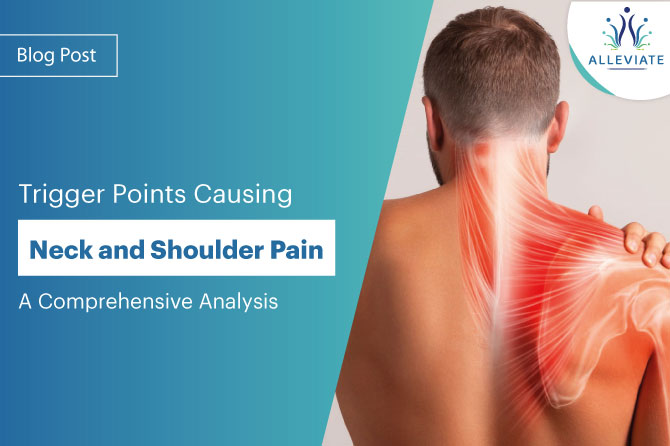Introduction
Neck and shoulder pain are common complaints experienced by people of all ages. While various factors can contribute to this discomfort, one often overlooked source is trigger points in specific muscles. These localized muscle knots can radiate pain to different areas of the body. In this comprehensive essay, we will focus on trigger points that cause neck and shoulder pain, examining the left and right Temporalis, Sternocleidomastoid (SCM), Upper Trapezius, Suboccipital muscles, Middle Trapezius, Lower Trapezius, Infraspinatus, Supraspinatus, Subscapularis, Teres minor, Teres major, Deltoid, Pectoralis major, Pectoralis minor, Biceps Brachii, Triceps Brachii, Scalene muscles, Subclavius, Masseter, Levator scapulae, Splenius capitis, and Rhomboid minor and major, as well as the Multifidus muscle group.
Left Temporalis and Right Temporalis
The Temporalis muscles, located on both sides of the head, are responsible for closing the jaw. Trigger points in these muscles can cause referred pain into the neck and shoulders. Left Temporalis trigger points may produce pain that radiates to the left side of the neck and upper shoulder, while Right Temporalis trigger points can refer pain to the right neck and shoulder regions.
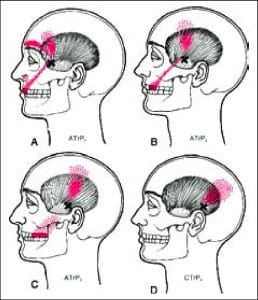
Left SCM(Sternocleidomastoid) and Right SCM
The Sternocleidomastoid (SCM) muscles are involved in neck rotation and flexion. Trigger points in these muscles are often associated with headaches and neck pain. Left SCM trigger points may cause pain radiating towards the left shoulder, while Right SCM trigger points can lead to pain in the right shoulder.
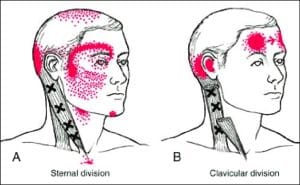
Left Upper Trapezius and Right Upper Trapezius
The Upper Trapezius muscle is a large muscle extending from the neck to the shoulders and upper back. Trigger points in the Upper Trapezius can cause significant neck and shoulder pain. Left Upper Trapezius trigger points often lead to pain in the left shoulder, and conversely, Right Upper Trapezius trigger points can result in right shoulder pain.
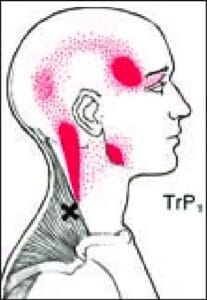
Suboccipital Muscles
The Suboccipital muscles are located at the base of the skull and are responsible for head and neck movements. Trigger points in these muscles can generate pain at the base of the skull, which may extend down the neck and into the shoulders.
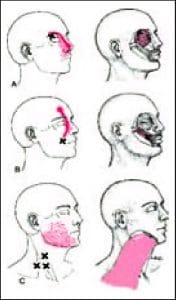
The Middle and Lower Trapezius muscles
The Middle and Lower Trapezius muscles situated in the upper back, assist in moving and stabilizing the shoulder blades. Trigger points in these muscles can produce referred pain that manifests in the form of upper back and shoulder discomfort.
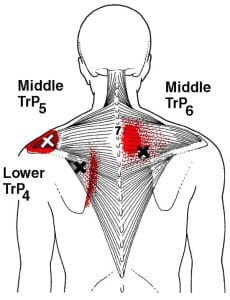
Left Infraspinatus and Right Infraspinatus
The Infraspinatus muscles, part of the rotator cuff, help in shoulder joint stability. Trigger points in the Infraspinatus can lead to pain in the shoulder region. Left Infraspinatus trigger points often generate pain in the left shoulder, whereas Right Infraspinatus trigger points may cause right shoulder pain.
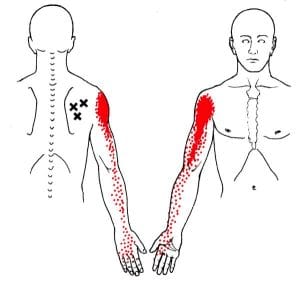
Supraspinatus
The Supraspinatus muscle is another component of the rotator cuff that plays a crucial role in shoulder movement. Trigger points in the Supraspinatus muscle can cause pain in the shoulder region, especially when moving the arm.
Subscapularis
The Subscapularis muscle is the largest muscle of the rotator cuff and aids in shoulder joint function. Trigger points in this muscle can contribute to shoulder pain and discomfort, particularly in the front of the shoulder.
Teres Minor and Teres Major
The Teres Minor and Teres Major muscles also play a role in shoulder movements. Trigger points in these muscles can produce shoulder pain, with the location of the pain corresponding to the affected muscle.
Left Deltoid and Right Deltoid
The Deltoid muscles are responsible for arm abduction and play a vital role in shoulder mobility. Trigger points in the Deltoid muscles can lead to pain and discomfort in the shoulder region, with different parts of the muscle causing pain in specific areas.
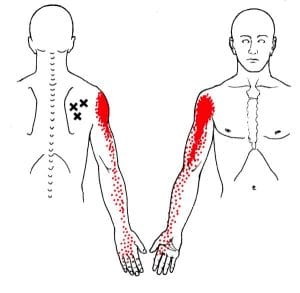
Pectoralis Major and Pectoralis Minor
The Pectoralis Major and Pectoralis Minor muscles are found in the chest area. Trigger points in these muscles can contribute to chest and shoulder pain, especially in the front of the shoulder.
Biceps Brachii and Triceps Brachii
The Biceps Brachii and Triceps Brachii muscles are located in the upper arm and play essential roles in arm movements. Trigger points in these muscles can lead to referred pain in the shoulder and upper arm.
Left Scalene and Right Scalene
The Scalene muscles are located on the sides of the neck and assist in neck and ribcage movements. Trigger points in these muscles can generate pain in the neck, which may radiate to the shoulder region.
Subclavius
The Subclavius muscle is located beneath the clavicle (collarbone) and aids in stabilizing the clavicle and shoulder joint. Trigger points in this muscle can cause pain in the clavicle area and potentially refer pain to the shoulder.
Left Masseter and Right Masseter
The Masseter muscles are involved in chewing and jaw movements. Trigger points in these muscles can lead to jaw, face, and neck pain, which may extend to the shoulder area.Referred pain pattern from the rhomboid (A), levator scapulae (B), trapezius (C), iliocostalis thoracic (D), scalene (E), and infraspinatus (F) muscles
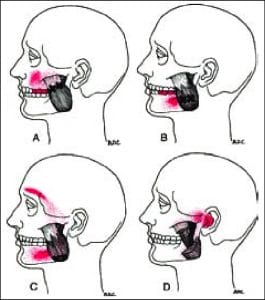
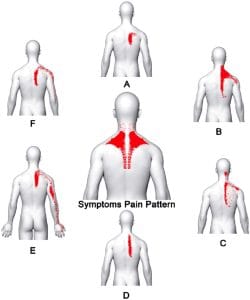
Left Levator Scapulae and Right Levator Scapulae
The Levator Scapulae muscles assist in elevating the shoulder blades. Trigger points in these muscles can cause pain at the base of the neck, which may radiate to the shoulder region.
Splenius Capitis
The Splenius Capitis muscle is located in the upper neck and is involved in neck movements. Trigger points in this muscle can generate pain in the upper neck, which may radiate to the shoulders.
Rhomboid Minor and Rhomboid Major
The Rhomboid Minor and Rhomboid Major muscles are positioned between the shoulder blades and are responsible for retracting the shoulder blades. Trigger points in these muscles can result in pain between the shoulder blades.
Multifidus
The Multifidus muscle group runs along the spine and assists in stabilizing the vertebral column. Trigger points in the Multifidus can produce localized back pain, which may extend to the shoulder area.
Conclusion
Trigger points in various muscles can contribute to neck and shoulder pain. Understanding the referral patterns of these trigger points is crucial for accurate diagnosis and effective treatment. It’s essential to consult with a healthcare professional or a qualified therapist who specializes in trigger point therapy to address and alleviate the pain associated with these trigger points. By targeting the root cause of the pain, individuals can experience relief and improved quality of life.
AT ALLEVIATE, we specialise in careful clinical assessment of suspected trigger points and practice a combination approach of Image guided trigger point injections along with physical therapy modalities to achieve resolution of pain and associated symptoms.



